
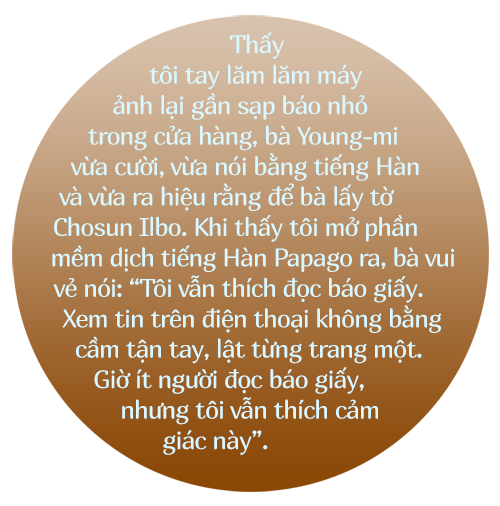
That morning, after the rain, the air in Seoul became cooler and fresher. On the wet sidewalk, the gentle sunlight filtered through the leaves, creating shimmering streaks of light. At the GS25 convenience store near Jongno 3-ga Station, a group of elderly people were holding printed newspapers, laughing and chatting. It turned out that they were discussing the analysis and commentary in Dong-A Ilbo about the live televised debate between the four presidential candidates.
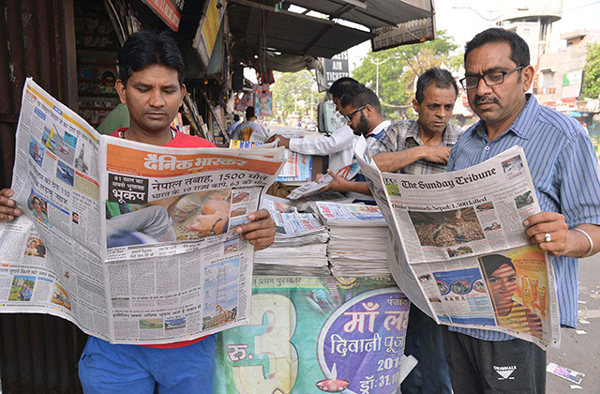
Seeing me approaching the small newspaper stand in the store with my camera in hand, Ms. Young-mi smiled and spoke in Korean, signaling for her to get the Chosun Ilbo. When she saw me open the Papago Korean translation software, she happily said, “I still like reading paper newspapers. Reading the news on my phone is not as good as holding it in my hand and turning the pages one by one. Few people read paper newspapers these days, but I still like this feeling.”
Mr. Hwang In-yeop, the owner of GS25, told me that every day he only receives about 80-100 printed newspapers of all kinds and puts them on the newspaper rack right in front of the store. Usually, around 9am-12pm, people will come to buy newspapers, mostly retired people and the elderly. Occasionally, people also buy newspapers in the evening. Mr. Hwang In-yeop also added that, compared to other convenience stores in the surrounding area (like CU), the number of newspapers he accepts for consignment at the store is still large, usually the stores only receive about 50-70 copies per day, some stores only take 20-30 copies.

“My store is located in the center of the city, so there are many people passing by, so there are more customers. I see that for the elderly, buying a newspaper is not only a habit, but also a part of their memories, a moment of connection with urban life and the outside world . Some elderly people even buy noodles or rice balls with a cup of coffee and sit at the dining table in the store, slowly turning the pages of the newspaper,” Hwang In-yeop shared.
A colleague of mine at The Korea Herald said that in the early 2000s, Koreans still had the habit of lining up to buy newspapers, but in the past eight years, the newspapers that used to be widely available on newsstands have dwindled to just a few copies, and the newspaper stands now occupy a modest corner, nestled between the bread shelves and the automatic coffee machines. Newspapers like Chosun Ilbo, JoongAng Ilbo, or Dong-A Ilbo… are displayed mainly to serve the loyal older readers – those who still keep the habit of reading news on paper, as part of a lifestyle that is not easy to change.
It is noteworthy that the image of small, familiar newspaper stands like this not only still appears in Korea but also in Japan, convenience stores such as 7-Eleven or Lawson also dedicate a small corner for printed newspapers, serving the middle-aged and elderly reader group. Meanwhile, in the island nation of Singapore, small newspaper shelves in convenience stores are preserved and become a symbol of the traditional way of receiving information in the heart of a modern city.


According to journalist Jamila Achakzai in Islamabad (Pakistan), although print newspapers in Asia are facing a decline in circulation, the home distribution system is still maintained to help these newspapers adapt better to the digital age. India is one of the very few countries where the home distribution system is still extremely strong. Newspapers such as: The Times of India, Dainik Bhaskar or Hindustan Times ... still maintain a distribution team of millions of copies of newspapers every day, stretching from urban to rural areas. A prominent feature is the "paperwallahs" - people who deliver newspapers early in the morning by bicycle or motorbike - have become a familiar image in residential areas. The cheap price of newspapers (under 10 rupees/paper, equivalent to less than 5,000 VND), thanks to the subsidy by advertising, makes print newspapers in India still a popular choice for the masses. The system operates on a highly efficient, highly localized and flexible model for each region.
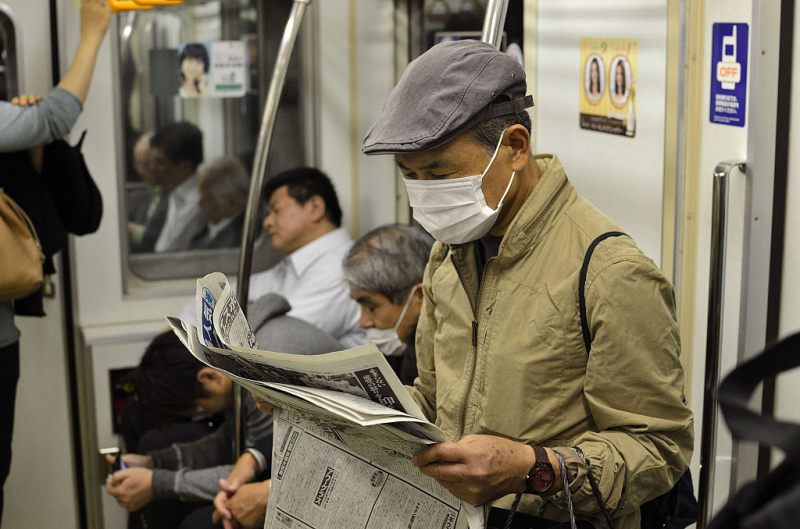
Meanwhile, in Japan, the culture of long-term newspaper subscriptions by month, quarter, or year is still popular among older readers. Newspapers such as Asahi Shimbun, Yomiuri Shimbun, Mainichi... operate a distribution system with branches called tokubai-ten (newspaper agents) that act as distribution centers to each household. According to 2022 statistics, Japan has about 14,000 newspaper agents nationwide and more than 200,000 people delivering newspapers early in the morning every day (usually from 2am to 5am).
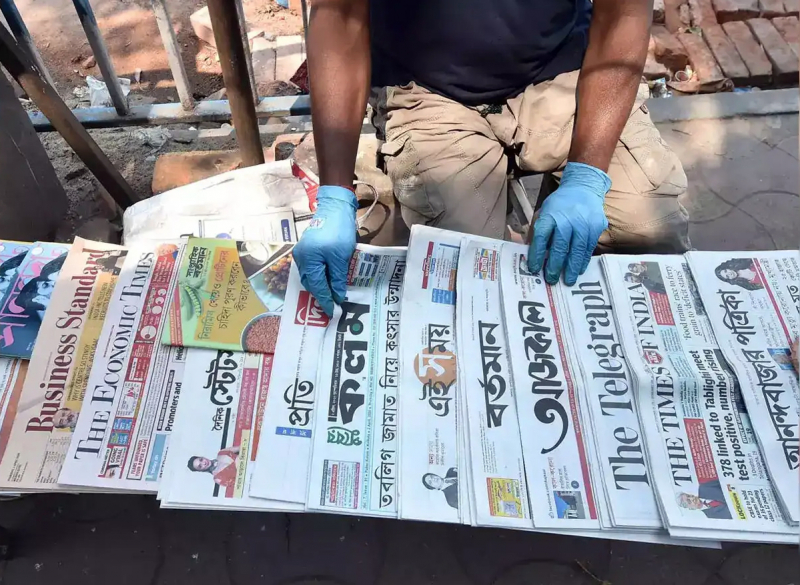
China, which once had a vast print newspaper distribution system through local post offices, has now largely gone digital. Some major newspapers, such as People's Daily, maintain print distribution to Party offices, schools and libraries, but for the general reader, print has largely been replaced by digital newspaper apps, video platforms or WeChat newsletters.
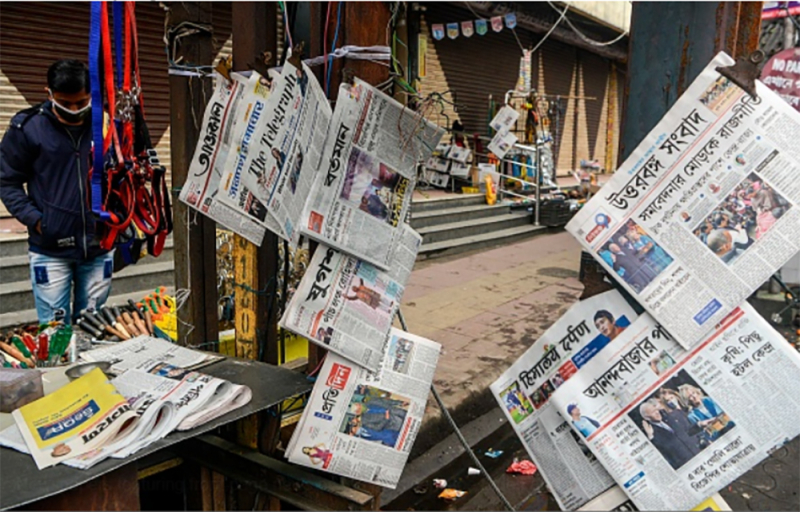

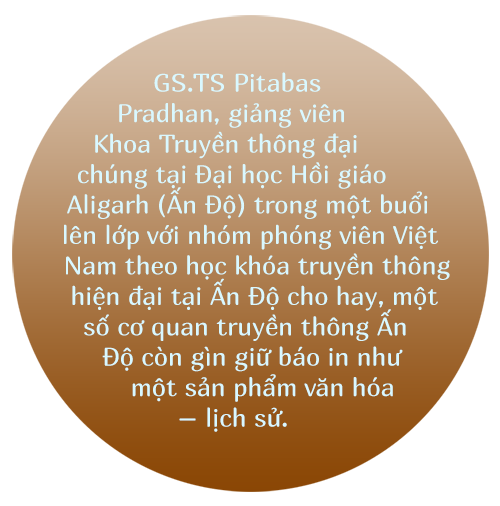
However, changes in information consumption habits, along with financial pressures, are gradually reducing the space for print newspapers to exist. Over the past decade, print newspapers have gradually had to cede their central position to digital news, where all information is updated in real time with just a few taps on the phone screen.

As in South Korea – a country that once boasted the most developed journalism in Asia – print newspapers are increasingly becoming a nostalgic memory rather than a mass media. The country’s popular newspapers, which once had a circulation of millions of copies per day, are now almost replaced by online news on platforms like Naver, Kakao or Youtube. A 2023 report by the Korean Ministry of Culture, Sports and Tourism said that print newspaper circulation in the country had dropped by more than 50% compared to 2010. Print advertising revenue has plummeted, forcing many newsrooms to cut staff, merge departments, or switch entirely to online newspapers.
South Korea’s situation is not unique. In China, large media groups such as People’s Daily and Southern Weekly have invested heavily in mobile apps, social media and streaming, reducing print newspapers to a mere ceremonial publication, mainly for government offices and libraries. Meanwhile, print newspapers in Japan have endured much longer, thanks largely to the deeply ingrained habit of reading the morning paper. The two largest newspapers – Yomiuri Shimbun and Asahi Shimbun – are still among the world’s largest daily newspapers, although their circulations have declined significantly since their peak. However, Japanese newsrooms have not been immune to the digital wave, with heavily invested digital editions and the beginning of experimentation with paid content.

In India or Pakistan, where print newspapers are still developing relatively stably because hundreds of millions of people (especially in rural areas) do not have regular access to the Internet, the number of print newspapers sometimes even recorded a slight increase (especially after COVID-19). However, print newspapers are not disappearing but are "retreating" to reposition themselves. Instead of competing with social networks or online news for speed, print newspapers now focus on depth, reliability and archival value; continuing to serve specific groups of readers such as: the elderly, scholars, teachers, or communities living in remote areas where the Internet is not yet widespread.
Prof. Dr. Pitabas Pradhan, lecturer of the Department of Mass Communication at Aligarh Muslim University (India), in a class with a group of Vietnamese reporters studying modern communication in India, said that some Indian media agencies still preserve printed newspapers as a cultural and historical product. The editorial offices invest in special issues such as Tet newspapers, annual magazines, scientific magazines... which are beautifully printed and elaborately presented as a way to preserve collective memories. Not to mention, they also hire a marketing team specializing in surveying the reading trends of print newspaper readers to produce appropriate articles and press products.

“This is also a notable direction in the context of print newspapers gradually leaving the role of mass consumer products,” Prof. Dr. Pitabas Pradhan emphasized, adding that, in addition to India, in Indonesia – the fourth most populous country in the world, print newspapers still maintain a more stable market share than many countries in the Asian region due to the high proportion of people living in rural areas and uneven access to the Internet. According to data from the Indonesian Press Association (Persatuan Wartawan Indonesia – PWI), as of 2023, there are still more than 300 print newspapers operating regularly, including big names such as Kompas, Media Indonesia, Jawa Pos.

According to Prof. Dr. Pitabas Pradhan, the reasons for the stability of print newspapers in Indonesia are, firstly, the distribution system combines traditional distribution and retail networks; secondly, media agencies also make efforts to provide cheap, compact paper versions to suit the economic conditions of ordinary readers. In addition, some newspapers such as Kompas have transformed print newspapers into "in-depth versions" specializing in analysis, long interviews, and investigative reports while the updated news section is pushed to digital platforms. "The strategy of dividing the product into two parts not only retains traditional readers but also attracts more young readers through applications and websites," Prof. Dr. Pitabas Pradhan commented.
Clearly, print is no longer the first source of news, but it is still a repository of reliable information. And in a world of information noise, that existence, combined with the reading habits of Asians, may be the reason why print continues to have a (modest) place in the digital society.
Statistics show that China currently leads the region with print newspaper revenue of about 8 billion USD, mostly from the Party newspaper and the state media system. In Japan, Yomiuri Shimbun holds the record for the newspaper with the largest circulation in the world, with nearly 5.8 million copies/day (according to June 2024 data from the Japan Newspaper Circulation Audit Bureau - JABC). Asahi Shimbun and Nikkei follow with more than 3.39 million and 1.3 million copies/day, respectively, while the number of online newspaper subscriptions is also increasing steadily.
In India, Dainik Bhaskar recorded an impressive increase of 150,000 copies/day in the first quarter of 2025, bringing its total circulation to about 4.3 million copies/day, while The Times of India reached more than 3.4 million copies/day. The newspaper publishing industry's revenue is estimated to be $6 billion and continues to grow (according to the Audit Bureau of Newspaper Circulations of India, first quarter of 2025).
Meanwhile, in Korea, newspaper industry revenue (including print and online newspapers) will reach about $3.38 billion in 2022 and increase to about $3.5 billion in 2024. Print newspaper advertising revenue alone will reach about $455 million in 2024. According to the Korea Press Foundation (KPF) and the Korea Press Circulation Inspection Agency (KABC), major newspapers such as The Chosun Ilbo, The Dong-A Ilbo, JoongAng Ilbo and Seoul Shinmun maintain circulations ranging from 780,000 to more than 1.2 million copies per day.
In Indonesia, print newspapers remain the dominant source of information in many non-urban areas, with major publishers such as Kompas Gramedia, Jawa Pos and Tempo dominating the market, with industry revenues of around US$2 billion – a significant figure for a developing country. In Malaysia, the newspaper market is stable, with Sin Chew Daily (Chinese) circulating around 340,000 copies a day and The Star (English) over 248,000 copies a day, reflecting the diversity of languages and social structures.
In Singapore, a small but lean market, print newspapers cater mainly to middle-aged and elderly readers. The Straits Times is still distributed regularly through convenience stores and subscriptions. Meanwhile, in Bangladesh and Pakistan, print newspapers play a vital role in rural areas and areas with poor internet infrastructure. Bangladesh’s Prothom Alo circulates about 500,000 copies a day, while Pakistan’s Urdu-language Jang leads with about 800,000 copies a day.
Source: https://cand.com.vn/Xa-hoi/bao-in-chau-a-tai-dinh-vi-thoi-ky-cong-nghe-so-i772132/





![[Photo] The 5th Patriotic Emulation Congress of the Central Inspection Commission](https://vphoto.vietnam.vn/thumb/1200x675/vietnam/resource/IMAGE/2025/10/27/1761566862838_ndo_br_1-1858-jpg.webp)























![[Photo] National Assembly Chairman Tran Thanh Man receives Chairman of the House of Representatives of Uzbekistan Nuriddin Ismoilov](https://vphoto.vietnam.vn/thumb/1200x675/vietnam/resource/IMAGE/2025/10/27/1761542647910_bnd-2610-jpg.webp)
![[Photo] Party Committees of Central Party agencies summarize the implementation of Resolution No. 18-NQ/TW and the direction of the Party Congress](https://vphoto.vietnam.vn/thumb/1200x675/vietnam/resource/IMAGE/2025/10/27/1761545645968_ndo_br_1-jpg.webp)



































![[Photo] Prime Minister attends the 28th ASEAN-China Summit](https://vphoto.vietnam.vn/thumb/402x226/vietnam/resource/IMAGE/2025/10/28/1761624895025_image-2.jpeg)








































Comment (0)